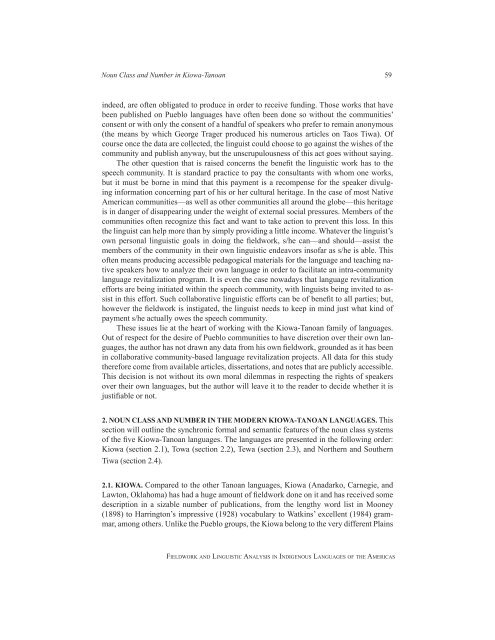Fieldwork and Linguistic Analysis in Indigenous ... - ScholarSpace
Fieldwork and Linguistic Analysis in Indigenous ... - ScholarSpace
Fieldwork and Linguistic Analysis in Indigenous ... - ScholarSpace
You also want an ePaper? Increase the reach of your titles
YUMPU automatically turns print PDFs into web optimized ePapers that Google loves.
Noun Class <strong>and</strong> Number <strong>in</strong> Kiowa-Tanoan 59<br />
<strong>in</strong>deed, are often obligated to produce <strong>in</strong> order to receive fund<strong>in</strong>g. Those works that have<br />
been published on Pueblo languages have often been done so without the communities’<br />
consent or with only the consent of a h<strong>and</strong>ful of speakers who prefer to rema<strong>in</strong> anonymous<br />
(the means by which George Trager produced his numerous articles on Taos Tiwa). Of<br />
course once the data are collected, the l<strong>in</strong>guist could choose to go aga<strong>in</strong>st the wishes of the<br />
community <strong>and</strong> publish anyway, but the unscrupulousness of this act goes without say<strong>in</strong>g.<br />
The other question that is raised concerns the benefit the l<strong>in</strong>guistic work has to the<br />
speech community. It is st<strong>and</strong>ard practice to pay the consultants with whom one works,<br />
but it must be borne <strong>in</strong> m<strong>in</strong>d that this payment is a recompense for the speaker divulg<strong>in</strong>g<br />
<strong>in</strong>formation concern<strong>in</strong>g part of his or her cultural heritage. In the case of most Native<br />
American communities—as well as other communities all around the globe—this heritage<br />
is <strong>in</strong> danger of disappear<strong>in</strong>g under the weight of external social pressures. Members of the<br />
communities often recognize this fact <strong>and</strong> want to take action to prevent this loss. In this<br />
the l<strong>in</strong>guist can help more than by simply provid<strong>in</strong>g a little <strong>in</strong>come. Whatever the l<strong>in</strong>guist’s<br />
own personal l<strong>in</strong>guistic goals <strong>in</strong> do<strong>in</strong>g the fieldwork, s/he can—<strong>and</strong> should—assist the<br />
members of the community <strong>in</strong> their own l<strong>in</strong>guistic endeavors <strong>in</strong>sofar as s/he is able. This<br />
often means produc<strong>in</strong>g accessible pedagogical materials for the language <strong>and</strong> teach<strong>in</strong>g native<br />
speakers how to analyze their own language <strong>in</strong> order to facilitate an <strong>in</strong>tra-community<br />
language revitalization program. It is even the case nowadays that language revitalization<br />
efforts are be<strong>in</strong>g <strong>in</strong>itiated with<strong>in</strong> the speech community, with l<strong>in</strong>guists be<strong>in</strong>g <strong>in</strong>vited to assist<br />
<strong>in</strong> this effort. Such collaborative l<strong>in</strong>guistic efforts can be of benefit to all parties; but,<br />
however the fieldwork is <strong>in</strong>stigated, the l<strong>in</strong>guist needs to keep <strong>in</strong> m<strong>in</strong>d just what k<strong>in</strong>d of<br />
payment s/he actually owes the speech community.<br />
These issues lie at the heart of work<strong>in</strong>g with the Kiowa-Tanoan family of languages.<br />
Out of respect for the desire of Pueblo communities to have discretion over their own languages,<br />
the author has not drawn any data from his own fieldwork, grounded as it has been<br />
<strong>in</strong> collaborative community-based language revitalization projects. All data for this study<br />
therefore come from available articles, dissertations, <strong>and</strong> notes that are publicly accessible.<br />
This decision is not without its own moral dilemmas <strong>in</strong> respect<strong>in</strong>g the rights of speakers<br />
over their own languages, but the author will leave it to the reader to decide whether it is<br />
justifiable or not.<br />
2. NOUN CLASS AND NUMBER IN THE MODERN KIOWA-TANOAN LANGUAGES. This<br />
section will outl<strong>in</strong>e the synchronic formal <strong>and</strong> semantic features of the noun class systems<br />
of the five Kiowa-Tanoan languages. The languages are presented <strong>in</strong> the follow<strong>in</strong>g order:<br />
Kiowa (section 2.1), Towa (section 2.2), Tewa (section 2.3), <strong>and</strong> Northern <strong>and</strong> Southern<br />
Tiwa (section 2.4).<br />
2.1. KIOWA. Compared to the other Tanoan languages, Kiowa (Anadarko, Carnegie, <strong>and</strong><br />
Lawton, Oklahoma) has had a huge amount of fieldwork done on it <strong>and</strong> has received some<br />
description <strong>in</strong> a sizable number of publications, from the lengthy word list <strong>in</strong> Mooney<br />
(1898) to Harr<strong>in</strong>gton’s impressive (1928) vocabulary to Watk<strong>in</strong>s’ excellent (1984) grammar,<br />
among others. Unlike the Pueblo groups, the Kiowa belong to the very different Pla<strong>in</strong>s<br />
fieldwork <strong>and</strong> l<strong>in</strong>guistic analysis <strong>in</strong> <strong>in</strong>digenous languages of the americas

















